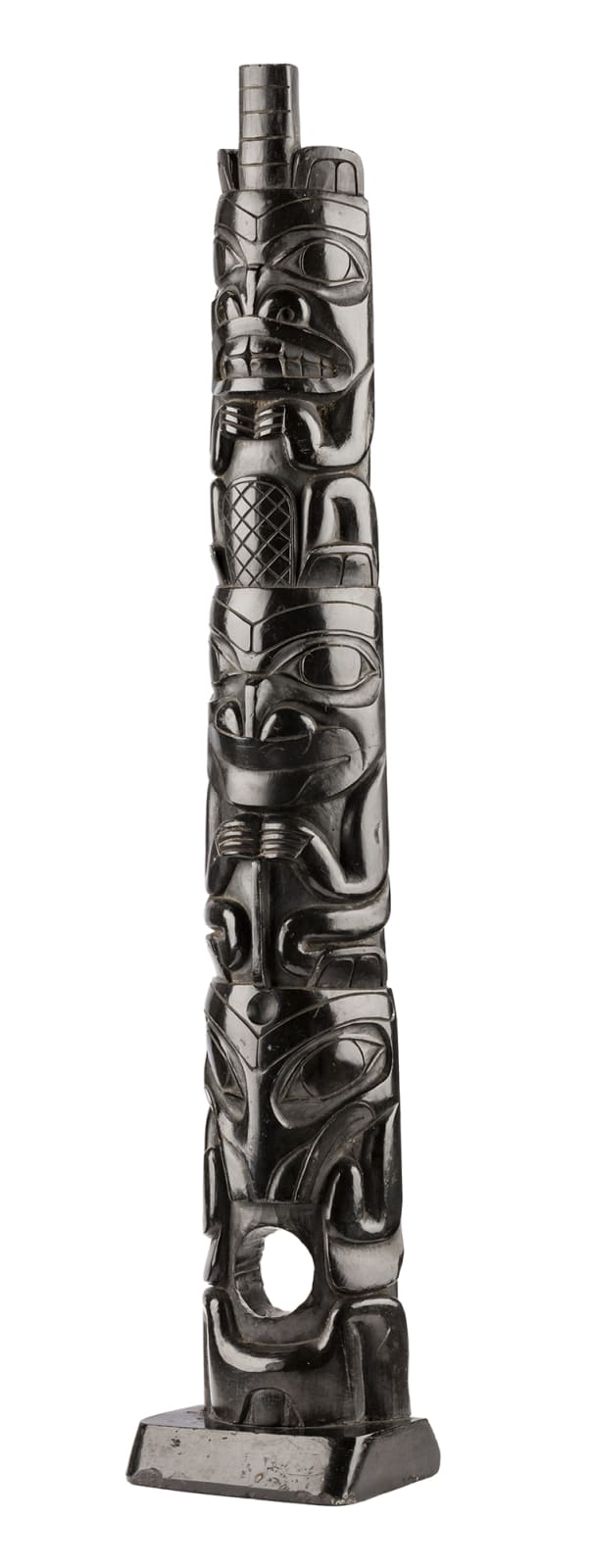-
Artworks
UNIDENTIFIED ARTIST, HAIDA
Model House Entry Totem Pole, c. 1870-80argillite, 17 x 2.5 x 3.25 in (43.2 x 6.3 x 8.3 cm)
unsigned.
LOT 34
ESTIMATE: $8,000 — $12,000
PRICE REALIZED: $4,800.00Further images
Carved in the style of the large cedar poles created by Haida artists for village display of family crests, this one includes a hole at the bottom, suggesting that it...Carved in the style of the large cedar poles created by Haida artists for village display of family crests, this one includes a hole at the bottom, suggesting that it was meant to represent a house entry pole. Like most Northwest Coast models, it may or may not be based on an original cedar pole carving. The straight back of the pole is hollowed out, in this case to lighten the sculpture. Full-size cedar poles were hollowed out for the same reason, as well as to minimize the checks or cracks that form as the surface dries in varying weather conditions.
Three large figures are represented, in each of which the heads are as large as the bodies, a common characteristic of monumental Haida totem poles. At the top is a beaver with a stack of five ‘hat rings’, or skil, extending up between its ears. Woven rings like these atop a spruce root hat are indicative of high status in Haida culture. The beaver’s four feet are drawn up in front of its body, and the scaly tail stands upright between the hind legs. The next figure is most likely a bear, with its tongue extending over its lower lip. Its hind feet are tucked behind what appear to be the ears of the bottom figure, just as the bear’s ears overlap the hind feet of the beaver above it. The bottom figure is a whale, which wouldn’t naturally feature upstanding ears of this type, but the artist included them out of context to match the other figures. The whale’s forehead includes a round blowhole, with its dorsal fin extending up between the forelegs of the bear as far as the front feet. On either side of the whale’s snout are mammal-like drawn-up legs, the feet hidden behind the snout and fin-like extensions coming down from its elbows. These also appear out of the ordinary. Beneath the cut-through hole is the whale’s double fluked tail, which is seemingly connected to what looks like drawn-up hind legs, another feature incorporated out of context to reflect the composition of the other figures. The integral base of the pole is not a separate piece as is often the case, but is carved out of the original piece of argillite along with the various figures.
Steven C. Brown
References: For a very similar contemporaneous pole, possibly by the same artist, see Peter L. Macnair and Alan J. Hoover, The Magic Leaves: A History of Haida Argillite Carving (Victoria: Royal BC Museum, 1984/2002), fig. 102.
Provenance
A British Columbia Collection.
Join our mailing list
* denotes required fields
We will process the personal data you have supplied in accordance with our privacy policy (available on request). You can unsubscribe or change your preferences at any time by clicking the link in our emails.












